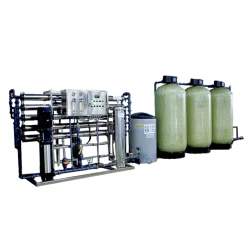How Reverse Osmosis Systems Work
2024-05-30
A reverse osmosis (RO) system is a water purification technology used to remove contaminants from water by forcing it through a semipermeable membrane. This process separates impurities from the water, producing clean, purified water suitable for drinking, cooking, and other purposes. Here's a detailed overview of reverse osmosis systems, including how they work, their components, benefits, and considerations for installation and maintenance:
How Reverse Osmosis Systems Work
1. Semipermeable Membrane:
- The heart of the RO system is a semipermeable membrane with extremely small pores that allow water molecules to pass through while blocking contaminants.
2. Pressure:
- Water is pressurized and forced through the membrane, creating a concentration gradient that separates pure water from impurities.
3. Separation of Contaminants:
- Dissolved solids, salts, minerals, chemicals, bacteria, viruses, and other contaminants are retained by the membrane, while purified water (permeate) passes through.
4. Reject Water:
- The concentrated solution containing the rejected contaminants (brine) is flushed away, leaving behind clean, purified water for consumption.
Components of Reverse Osmosis Systems
1. Pre-filtration:
- Sediment filter: Removes large particles such as sand, dirt, and rust.
- Carbon filter: Removes chlorine, chemicals, odors, and organic compounds.
2. Reverse Osmosis Membrane:
- The semipermeable membrane that removes dissolved solids, contaminants, and impurities from the water.
3. Post-filtration:
- Carbon filter: Further polishes the water, removing any remaining tastes, odors, or residual contaminants.
- Final polishing filter: Provides additional filtration for improving water quality.
4. Storage Tank:
- Stores the purified water until it is needed, ensuring a continuous supply of clean water.
5. Faucet:
- Dispenses purified water for drinking, cooking, and other household uses.
6. Pressure Pump (optional):
- Boosts water pressure to optimize the efficiency of the RO system, especially in low-pressure environments.
Benefits of Reverse Osmosis Systems
1. Removal of Contaminants:
- Effectively removes a wide range of contaminants, including dissolved solids, chemicals, heavy metals, bacteria, viruses, and microorganisms.
2. Improved Taste and Odor:
- Produces clean, fresh-tasting water free from unpleasant tastes, odors, and impurities.
3. Healthier Drinking Water:
- Provides safe and healthy drinking water by reducing exposure to harmful contaminants and pathogens.
4. Cost Savings:
- Eliminates the need for bottled water, saving money over time and reducing plastic waste.
5. Convenience:
- Offers on-demand access to purified water directly from the tap, eliminating the need to purchase and store bottled water.
6. Versatility:
- Suitable for residential, commercial, and industrial applications, providing clean water for various uses.
Considerations for Reverse Osmosis Systems
1. Water Quality:
- Consider the quality of your water source and the specific contaminants you need to remove when choosing an RO system.
2. Water Pressure:
- Ensure adequate water pressure for optimal performance of the RO system, especially if a pressure pump is not included.
3. System Size and Capacity:
- Choose an RO system with the appropriate capacity to meet your household's water usage needs.
4. Installation:
- Follow manufacturer instructions or hire a professional for proper installation and setup of the RO system.
5. Maintenance:
- Regular maintenance, including filter replacement and system sanitization, is essential for optimal performance and longevity of the RO system.
6. Waste Water:
- Consider the amount of reject water produced by the RO system and its disposal, as it can vary depending on system efficiency and water quality.
Conclusion
Reverse osmosis systems provide an effective solution for producing clean, purified water free from contaminants and impurities. By understanding how these systems work, their components, benefits, and considerations for installation and maintenance, you can make informed decisions about selecting and implementing an RO system that meets your water purification needs. Whether for residential, commercial, or industrial use, reverse osmosis systems offer a reliable and convenient way to ensure access to safe, high-quality drinking water.



